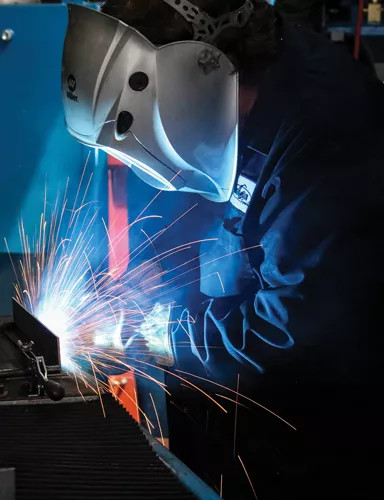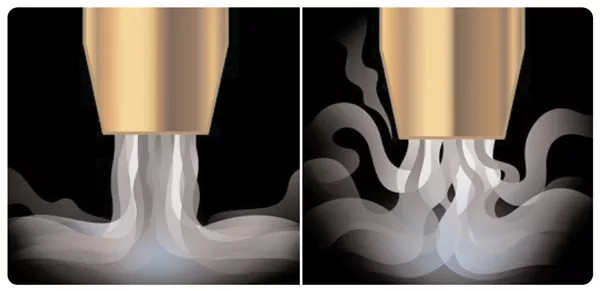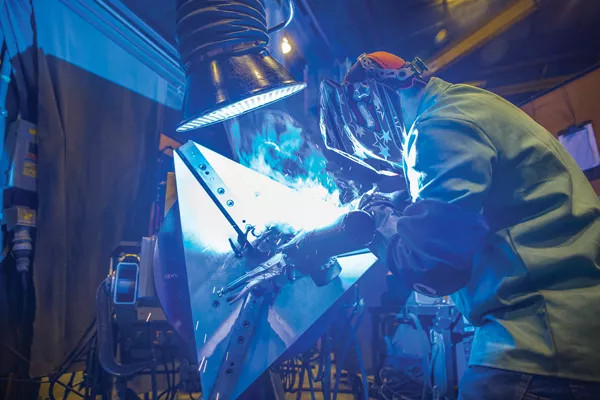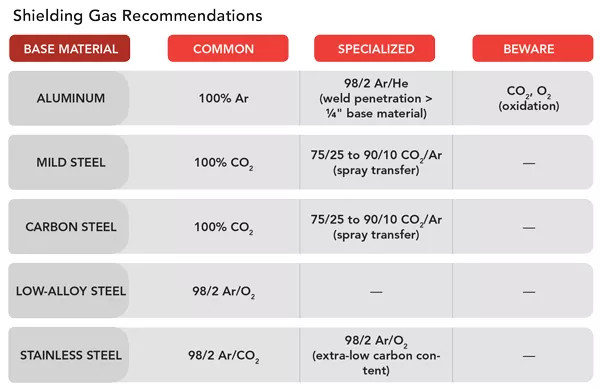Using the wrong shielding gas or gas flow can affect weld quality, costs, and productivity significantly. Shielding gas protects the molten weld pool from outside contamination, so it’s critical to choose the right gas for the job.
For best results, it’s important to know which gases and gas mixes are best suited for certain materials. You should also be aware of a few tips that can help you optimize gas performance in your welding operation, which can save you money.
Several shielding gas options for gas metal arc welding (GMAW) can get the job done. Choosing the gas that’s best suited for the base material, transfer mode, and welding parameters can help you get the most out of the investment.

Choosing the gas that’s best suited for the base material, transfer mode, and welding parameters can help you get the most out of your investment.
Poor Shielding Gas Performance
Proper gas flow and coverage are important from the moment the welding arc is struck. Typically, problems with gas flow are immediately noticeable. You may have trouble establishing or sustaining an arc or find it difficult to produce quality welds.
Beyond quality issues, poor shielding gas performance can also drive up costs in the operation. A flow rate that is too high, for example, means you are wasting gas and spending more money on shielding gas than you need to.
Flow rates that are too high or too low can cause porosity, which then requires time for troubleshooting and rework. Flow rates that are too low can cause weld defects because the weld pool isn’t being adequately protected.
The amount of spatter produced during welding is also related to the shielding gas being used. More spatter means more time and money spent on postweld grinding.
How to Choose a Shielding Gas
Several factors determine the right shielding gas for the GMAW process, including the type of material, filler metal, and weld transfer mode.
Material Type. This may be the biggest factor to consider for the application. For example, carbon steel and aluminum have very different characteristics and therefore require different shielding gases to achieve the best results. You also have to take into account the material thickness when selecting a shielding gas.
Filler Metal Type. The filler metal matches the base material, so understanding the material should give you a good idea about the best gas for the filler metal as well. Many weld procedure specifications include details on what gas mixes can be used with specific filler metals.

Proper shielding gas flow and coverage are important from the moment the welding arc is struck. This diagram shows smooth flow on the left, which will cover the weld pool, and turbulent flow on the right.
Welding transfer mode. It may be short-circuit, spray-arc, pulsed-arc, or globular transfer. Each mode pairs better with certain shielding gases. For example, you should never use 100 percent argon with a spray transfer mode. Instead, use a mixture such as 90 percent argon and 10 percent carbon dioxide. The CO2 level in the gas mixture should never exceed 25 percent.
Additional factors to consider include travel speed, the type of penetration required for the joint, and part fit-up. Is the weld out of position? If so, that will also affect which shielding gas you choose.
Shielding Gas Options for GMAW
Argon, helium, CO2, and oxygen are the most common shielding gases used in GMAW. Each gas has benefits and drawbacks in any given application. Some gases are better suited than others for the most commonly used base materials, whether it’s aluminum, mild steel, carbon steel, low-alloy steel, or stainless steel.
CO2 and oxygen are reactive gases, meaning they affect what’s happening in the weld pool. The electrons of these gases react with the weld pool to produce different characteristics. Argon and helium are inert gases, so they don’t react with the base material or weld pool.
For example, pure CO2 provides very deep weld penetration, which is useful for welding thick material. But in its pure form it produces a less stable arc and more spatter compared to when it’s mixed with other gases. If weld quality and appearance are important, an argon/CO2 mixture can provide arc stability, weld pool control, and reduced spatter.
So, which gases pair best with different base materials?
Aluminum. You should use 100 percent argon for aluminum. An argon/helium mix works well if you require deeper penetration or a faster travel speed. Refrain from using an oxygen shielding gas with aluminum because oxygen tends to run hot and adds a layer of oxidation.
Mild steel. You can pair this material with a variety of shielding gas options, including 100 percent CO2 or a CO2/argon mix. As the material gets thicker, adding oxygen to an argon gas can help with penetration.
Carbon steel. This material pairs well with 100 percent CO2 or a CO2/argon mix. Low-alloy steel. A 98 percent argon/2 percent oxygen gas mix is well suited for this material.

Using the wrong shielding gas or gas flow can significantly impact weld quality, costs, and productivity in your GMAW applications.
Stainless steel. Argon mixed with 2 to 5 percent CO2 is the norm. When you require extra-low carbon content in the weld, use argon with 1 to 2 percent oxygen.
How-to Tips Optimize Shielding Gas Performance
Choosing the right shielding gas is the first step toward success. Optimizing performance—saving time and money—requires you to be aware of some best practices that can help conserve shielding gas and promote proper coverage of the weld pool.
Flow Rate. The proper flow rate depends on many factors, including the travel speed and the amount of mill scale on the base material. A turbulent gas flow during welding typically means the flow rate, measured in cubic feet per hour (CFH), is too high, and this can cause problems such as porosity. If any welding parameters change, this can affect the gas flow rate.
For example, increasing the wire feed speed also increases either the size of the weld profile or the travel speed, which means you may need a higher gas flow rate to ensure proper coverage.
Consumables. The GMAW gun consumables, consisting of a diffuser, contact tip, and nozzle, play a crucial role in ensuring that the weld pool is properly protected from the atmosphere. If the nozzle is too narrow for the application or if the diffuser becomes clogged with spatter, too little shielding gas might be getting to the weld pool. Choose consumables that resist spatter buildup and provide a wide enough nozzle bore to ensure adequate gas coverage. Also, be sure the contact tip recess is correct.
Gas Preflow. Running the shielding gas for a few seconds before striking the arc can help ensure there is adequate coverage. Using a gas preflow can be especially helpful when welding deep grooves or bevels that require a longer wire stick-out. A preflow that fills the joint with gas before starting may allow you to turn down the gas flow rate, thereby conserving gas and reducing costs.
System Maintenance. When using a bulk gas system, conduct proper maintenance to help optimize performance. Every connection point in the system is a possible source of a gas leak, so monitor all connections to make sure they’re tight. Otherwise, you may be losing some of the shielding gas that you think is getting to the weld.
Gas Regulator. Be sure to use the right regulator based on the gas mix you’re using. Precise mixing is important for weld protection. Using an improper regulator for the gas mix, or using the wrong type of connectors, can also result in safety concerns. Check regulators frequently to help ensure they’re working properly.
Gun Updates. If you are using an out-of-date gun, look into updated models that offer benefits, such as a smaller interior diameter and an isolated gas hose line, which allows you to use a lower gas flow rate. This helps prevent turbulence in the weld pool while also conserving gas.

Post time: Dec-30-2022



